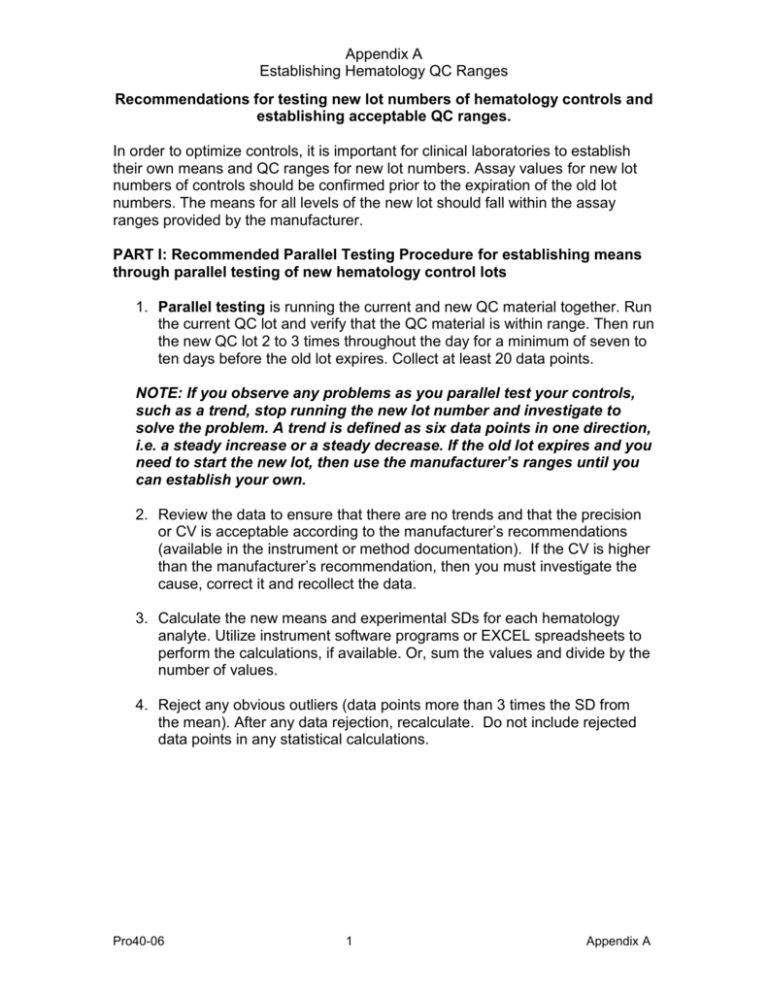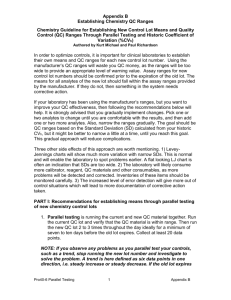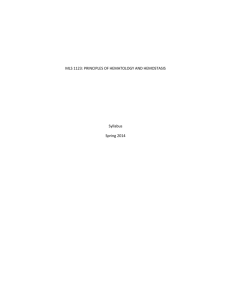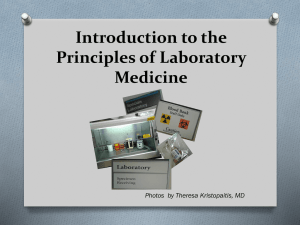Pro4.0-06 Appendix A Establishing Hematology QC Ranges
advertisement

Appendix A Establishing Hematology QC Ranges Recommendations for testing new lot numbers of hematology controls and establishing acceptable QC ranges. In order to optimize controls, it is important for clinical laboratories to establish their own means and QC ranges for new lot numbers. Assay values for new lot numbers of controls should be confirmed prior to the expiration of the old lot numbers. The means for all levels of the new lot should fall within the assay ranges provided by the manufacturer. PART I: Recommended Parallel Testing Procedure for establishing means through parallel testing of new hematology control lots 1. Parallel testing is running the current and new QC material together. Run the current QC lot and verify that the QC material is within range. Then run the new QC lot 2 to 3 times throughout the day for a minimum of seven to ten days before the old lot expires. Collect at least 20 data points. NOTE: If you observe any problems as you parallel test your controls, such as a trend, stop running the new lot number and investigate to solve the problem. A trend is defined as six data points in one direction, i.e. a steady increase or a steady decrease. If the old lot expires and you need to start the new lot, then use the manufacturer’s ranges until you can establish your own. 2. Review the data to ensure that there are no trends and that the precision or CV is acceptable according to the manufacturer’s recommendations (available in the instrument or method documentation). If the CV is higher than the manufacturer’s recommendation, then you must investigate the cause, correct it and recollect the data. 3. Calculate the new means and experimental SDs for each hematology analyte. Utilize instrument software programs or EXCEL spreadsheets to perform the calculations, if available. Or, sum the values and divide by the number of values. 4. Reject any obvious outliers (data points more than 3 times the SD from the mean). After any data rejection, recalculate. Do not include rejected data points in any statistical calculations. Pro40-06 1 Appendix A Appendix A Establishing Hematology QC Ranges PART II: Establishing Historical CV (CVh) CVh is the historical instrument precision for that method measured as a percent (%CV = SD/Mean X 100). It can be used to establish Standard Deviation (SD), QC ranges and to monitor your instrument precision. The CVh is best established over several lots (3 or more) and can either be the average CV or more preferably, the highest acceptable CV over that period. CVs obtained during times of instrument malfunction or significantly higher than the average CV should not be used in calculations. If you have no past lot CV data, then use the current CV as the CVh base and modify this value as you move on to subsequent new lots. This base value will need to be increased slightly (~12%) in order to establish QC ranges that are not too narrow. PART III: Recommended Procedure for establishing QC ranges using CVh 1. From the data created by the parallel testing in Part I above, calculate the CV and SD for the new control. Standard Deviation is “s” in the following typical formula. It is much easier to use a calculator or an EXCEL spreadsheet for this calculation. 2. The calculated new lot CV must be less than the manufacturer’s instrument-method CV and should approximate the CVh. If it is not, then there is a precision problem with your instrument. 3. Calculate the new control range by using the new mean with the SD determined by the equation (SD = CVh /100 X Mean). The number of SDs on either side of the mean can vary, but in most laboratories the QC range will be +/- 2 SD of the mean. See the example in section IV below. QC ranges established by this method will be more sensitive to changes and will thus alert laboratory personnel, when there are significant changes in a testing system PART IV: Example New hematology controls have arrived a month before the old lot expires or runs out. The laboratory was able to obtain enough new control to last until its expiration date. The lab staff ran the new lot of controls in parallel with the old lot for more than 7 days two or three times each day until they had 20 data points. They then calculated the new mean for each control and for each analyte. Pro40-06 2 Appendix A Appendix A Establishing Hematology QC Ranges Hemoglobin Normal Control Mean The manufacturer, in their control package insert, stated that the hemoglobin normal control mean should be between 12.5 and 13.5 g/dL. The lab recovered a mean of 13.2 g/dL from the parallel testing. This became the new mean for the normal hemoglobin control. Hemoglobin Normal Control SD The manufacturer of Analyzer XYZ states that their instrument’s precision for the hemoglobin method is 1.0%. The last three lots of the normal control had CVs of 0.8, 0.6 and 0.9. These results show that the instrument-method precision is performing as designed. The historic average CV is 0.76% and the historic highest CV is 0.9%. It was decided to use 0.9 as the historic CVh. The lab used this formula to calculate their new SD goal SD = CVh X mean 100 Hemoglobin Normal Control Lot 001: Mean = 13.2 g/dL and the CVh = 0.9% SD= 0.9 X 13.2 = 0.118 100 The laboratory uses a +/- 2 SD range for this assay, so the control range became: Range = Mean +/- 2 SD (13.2 +/- 0.236 or 12.96 – 13.43). This range was monitored and adjusted as more data was accumulated. A record of all changes to the QC settings in the instrument was kept in a log. The laboratory would then go through the same steps for the low and high controls and other CBC parameters. Pro40-06 3 Appendix A





